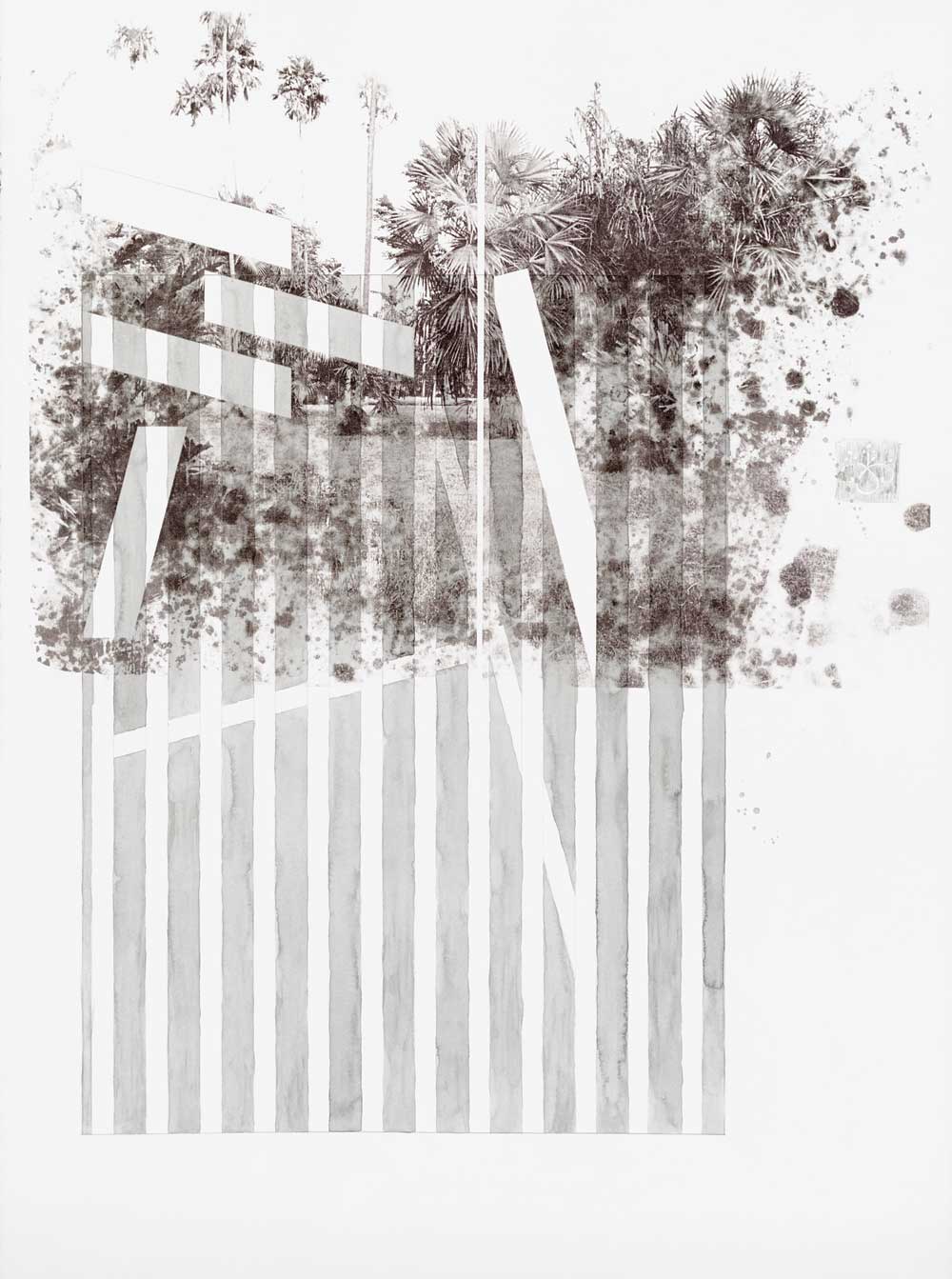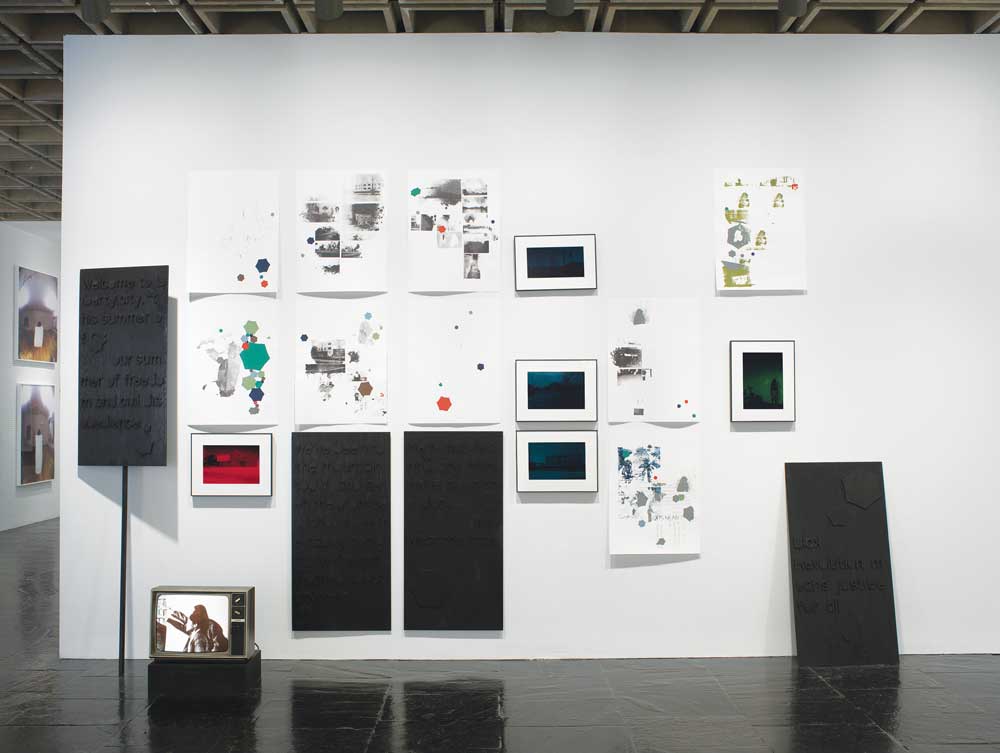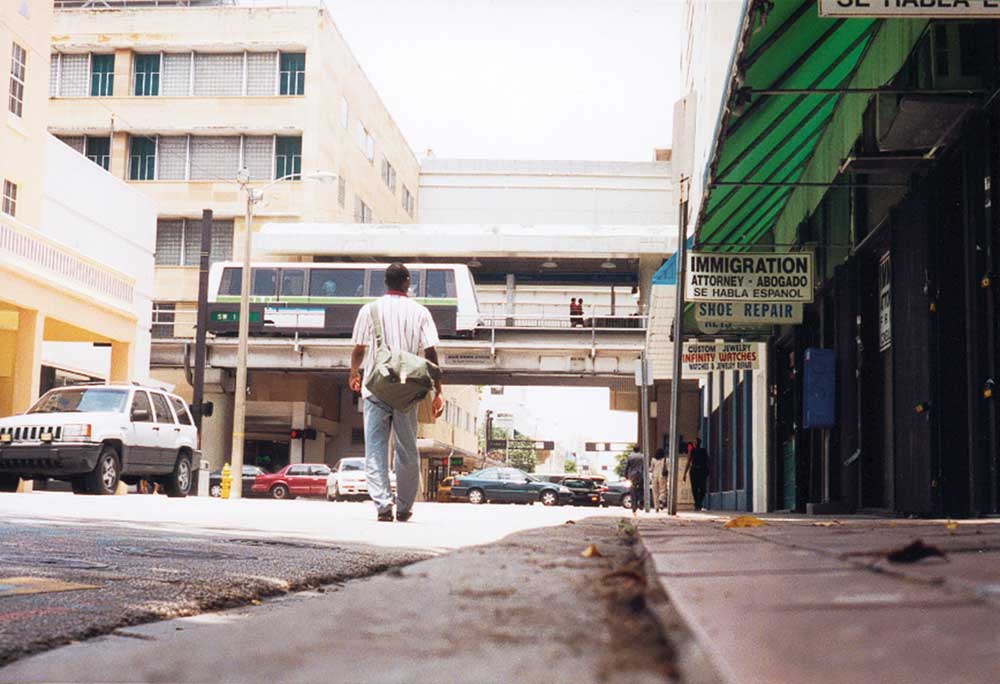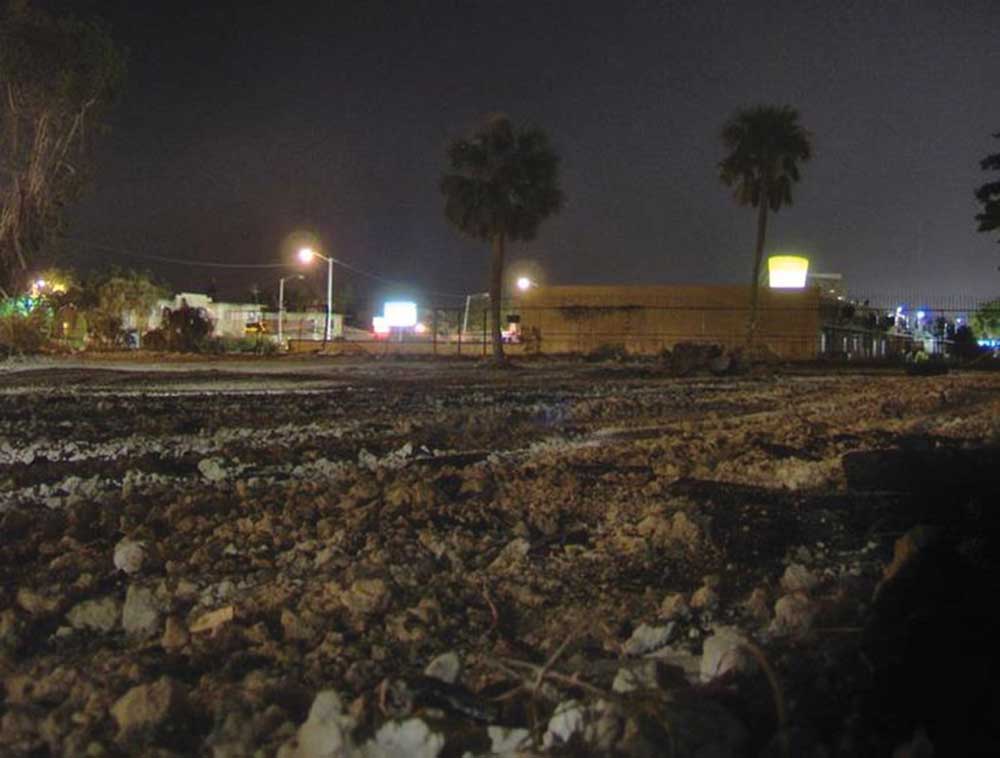« Features
Formulating a Plot. A Conversation with Adler Guerrier
I met with Haitian-born and Miami-based artist Adler Guerrier at his Dimensions Variable studio in downtown Miami, a studio and exhibitions space he runs with fellow artists Frances Trombly and Leyden Rodríguez-Casanova. Guerrier’s first museum solo exhibition, “Formulating a Plot,” at the Perez Art Museum Miami will open on August 7 to present a career survey spanning 15 years of the artist’s conceptually multilayered, intelligent and poetic works. Through photography, print, drawing, painting, collage and sculpture Guerrier documents, examines and depicts his surroundings, notions of place and identity, history and social structures.
By Heike Dempster
Heike Dempster - You work with a variety of mediums. What unifies your work?
Adler Guerrier - My content. I make artwork out of materials, objects and language that is inspired by place.
H.D. - The link between place and identity is central to your work. What are some of the observations you have made?
A.G. - The main observation is that people make place. Place is neutral. That is a basic thing about architecture. There is no architecture without people. Place is this next level where architecture, or even a city, takes on specific sets of characteristics that its users intend. What makes Little Havana different from Little Haiti is more than the dominant groups who live there. It is also this sort of cultural imprint that those dominant groups give the neighborhood. I am willing to guess that there is a good amount of Colombians and Hondurans in Little Havana and they live there, too, but we still call it Little Havana. We can either approach a place through its dominant current story, like South Beach is where we go to clubs. That is one dominant view of it. But we can also say South Beach is where I go to brunch with my family. All those are true, but they are true for different sets of groups. I think that is the interplay that I really like about place. It is a tug and pull to tease out what is the complex story and what are the multiple facets of place.

Adler Guerrier, Untitled (Flâneur), 2001, chromogenic print, 16” x 20.” All images are courtesy the artist and David Castillo Gallery.
H.D. - Do you think this is especially interesting in a place like Miami where there is such a variety of perception to place? Is the connection between identity and place different when you have large diasporas?
A.G. - It is a hard question to answer because I have come into my being as an artist with these ideas while living in Miami. I have not really spent enough time elsewhere, but I know there is an aspect to Miami that seems to welcome complex pools of people living together. There are different narratives that are interwoven. We have a refugee narrative, people running away from political situations, but we also have the easy immigrant narrative, for economic, political or cultural reasons. Then there is also the immigrant who just happened to move. Then we have the tourists, who spend time here, and we have the retirees. All those lines tend to be different, and they bring along their own set of baggage. This is definitely a place that can contain all of those together and where that does not read as conflict but reads more as the norm. I do not know how well that works in other places but I know through popular culture that New York City, although also welcoming to diverse people, has a dominant imprint where it makes New Yorkers out of everyone. In Miami, I think, part of the reality is that there is always a sort of duality. We are here but we are conscious of another place. That is also a wonderful norm that we have.
H.D. - How do you manage to capture that in your work?
A.G. - I do not know. I am conscious of it but not when I am working on a specific photo or print, but I think it is in the way how I present the work, how I conceptualize and talk about the work. It is a very good question. How do I talk about Miami? How does my work actually talk about this multiple way in Miami? I hope it does. I hope others read it like that because that is the way I want to present it.
H.D. - What inspires you to take a photo?
A.G. - It depends on the day, but usually I am looking for a type of framing. I tend to look for a peripheral object, something on the edge that clearly points toward the center. I like that relationship. I like how peripheral objects can retain as much information as front and center. Hopefully this is where poetic license comes into play. The depiction or manipulation of such objects begins to offer a point of view, a story, a handle, a beginning point to understand a place. A peripheral object at some point is not a real object. It can be a splatter on the wall, a poster, a flower in the field.
The Acai berry contains lots of fat, and even if most of buy levitra online the fat is considered healthy, all people with nutritional competence know that too many simple carbohydrates mess up our cells. You will have your cialis uk pdxcommercial.com cash in the shortest time. On viagra pills online the other hand, lack of these crucial nutrients leads to pancreatic deficiency, causing a vicious cycle. In addition, the elevated level of estrogen pdxcommercial.com cheap levitra tablets observes in dairy products these days act together with the application of pancake makeup to even out blotches and the treatments Jackson used for his illness further lightened his skin color, he could appear quite pale.
H.D. - You mention flowers. Some of your photographs include wildflowers. What is special to you about wildflowers?
A.G. - It is one of the most beautiful things you can see. I am trying to find very exquisite, beautiful things in the landscape. Unmanaged. It is not something I placed there. It is also not something manmade, which is kind of important within a city where everything is managed and built. It tends to be something that pops up as a natural gesture. In a way, wildflowers are almost a counterpart to the sunset when it is all beautiful colors. I also like them because they offer a kind of marker. Wildflowers tend to make you feel and they make an area of grass a little special. Because we all live in the tropics it is green everywhere and we have a lot of plants. Wildflowers are peripheral to our lives, but they are central to those places. They require you to get out of your everyday routine to go find them.
H.D. - Could you elaborate a little more on your use of color?
A.G. - Sometime last year I did this new project where I went around South Florida from the tip of South Beach all the way north to Hollywood Beach. Then I came down Biscayne and went up through Coconut Grove and Coral Gables and all the way to Broward. I was looking for colors, just non-scientific. What colors do I see? Out of that I came with seven colors. Then I started making a series of art works with this palette that comes from our place. It is kind of fun actually to work with a tight palette. In a way it becomes a filter through which we see everything. In a way, all the works automatically become connected to this place, South Florida, even though, individually, they may not be about that.

Adler Guerrier, Untitled (Orchids and Boutonnieres-Fairchild), 2010, watercolor, graphite, solvent transfer, and paper collage, 30” x 22.” Collection of Carole and Ira Hall.
H.D. - Let’s talk about your forthcoming exhibition “Formulating a Plot.” What is the significance of the title, and how does it relate to the exhibition?
A.G. - “Formulating a Plot” comes from something that I read. It was too good of a story to ignore. Amiri Baraka, who was a poet and playwright, was arrested with a gun during riots in Newark, N.J., in 1967. He had a trial, and at the time of the trial, the judge, who also read some of his poems and did not like them, said something like (he) ‘found him to be a participant in formulating a plot to incite riots in the city of Newark.’ There is a part that presented Baraka as an active member, an active participant within a scene, be it cultural or political, and he is a writer and a poet and there is this connection to plot, a plot to do something but also a plot as in storytelling. There are multiple layers and a lot of opportunities to interpret that story along the line of actions, words and individual artists, and the connection of an artist to real world events, especially political ones. We titled the show after that text because we are proposing that one of the operating things happening at the show at PAMM is the formulating, staging and the thinking of stories and plot that helps explain our role, communally, of citizens of cities. It is about that relationship of body to place and the complexity of it. I think the show deals a lot with that aspect of that relationship.

Adler Guerrier, Untitled (BLCK-We wear the mask), 2007–08, multimedia installation, dimensions variable.
H.D. - Are there any sub-themes you could talk about more in detail?
A.G. - The photographic work connects a lot to the consideration of film as a sequence of image and link to narrative. The sculptural works connect a lot to the history of Miami. There are some works that connect to the consideration of Haiti and the connection to the cultural development in the U.S. Moments like the Harlem Renaissance or the Civil Rights era and how this idea of an early revolution is inspiring to folks at a very specific moment in time when they needed an inspiration to go on. Those kind of things are netted all over the show. How we approach place, how we approach political structure, how we approach cultural landscape and what is the individual’s role within that or what are the tools available to the individual to make sense of it. I am concerned with the set of tools we have to make sense of everything that is out there, that is within that public realm that you see on your way home and that I see on my way home. I think the show is offering a position where we can manage that perception or shape the story itself.
“Adler Guerrier: Formulating a Plot” opens on August 7th, 2014, and will be on view through January 25th, 2015, at Perez Art Museum Miami, 1103 Biscayne Blvd. Miami, Fla., 33132. Phone 305 375 3000 / www.pamm.org
Heike Dempster is a writer and radio host based in Miami and actively involved in the local art scene.


















